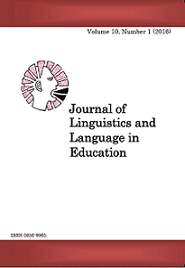Fulfulde as a Vehicular Language: An Opportunity or a Threat to Minority Languages in Maroua?
Abstract
It is increasingly recognized that most minority language speakers tend to give
up their languages in favour of a vehicular language as they move to urban
centres. In recent years, the degree of endangerment of indigenous languages
seems to be accelerating due to the increased dominance of Fulfulde. This study
seeks to find out whether the seeming progressive abandonment of local
languages in the Far North region of Cameroon is due to Fulfulde or French.
Data was obtained through participant observation and questionnaire
administration. The results indicate that Fulfulde, and to a certain extent
French tend to monopolize most of the proposed domains of language use. The
findings show that the respondents have limited fluency in their Mother
Tongues. They ô€„ô€ô€–ô€’ô€€ƒ ô€•ô€ˆô€™ô€ˆô€„ô€ô€€ƒ ô€—ô€‹ô€„ô€—ô€€ƒ ô€€©ô€˜ô€ô€‰ô€˜ô€ô€‡ô€ˆô€€ƒ ô€Œô€–ô€€ƒ ô€Šô€•ô€„ô€‡ô€˜ô€„ô€ô€ô€œô€€ƒ ô€…ô€ˆô€†ô€’ô€ô€Œô€‘ô€Šô€€ƒ ô€“ô€„ô€•ô€—ô€Œô€†ô€Œô€“ô€„ô€‘ô€—ô€–ô€‚·
Mother Tongues, and they considered it as a potential threat to minority
languages. It concludes that minority languages are threatened more by
Fulfulde than French in Maroua.
Key words: Endangerment, shift, multilingualism, contact, domains
References
References
Batibo, H. M. (1992). The Fate of Ethnic Languages in Tanzania. In
M. Brenzinger (ed.). Language Death: Factual and Theoretical
Explorations, with Special Reference to East Africa. Berlin:
Mouton de Gruyter: 85􀂲98.
Batibo, H. M. (1997). The Fate of the Minority Languages of
Botswana. In B. Smieja & M. Tasch (eds.). Human Contact
through Language and Linguistics. Frankfort: Peter Lang:
􀂲252.
| Fulfulde as a Vehicular Language
Batibo, H. M. (2002). The Fate of the Khoesan Languages of
Botswana. In M. Brenzinger (ed.). Endangered Languages in
Africa.Cologne: Rüdiger Köppe: 187􀂲205.
Batibo, H. M. (2005). Language Decline and Death in Africa:
Courses, Consequences and Challenges. Clevedon:
Multilingual Matters.
Batibo, H. M. (2006). The Bilingualism Markedness Model. Malilime,
: 1􀂲26.
Brezinger, M. et al. (2003). Language Vitality and Endangerment.
Paris: UNESCO (Intangible Cultural Heritage Unit).
Brenzinger, M., B. Heine & Summer, G. (1991). Language Death in
Africa. In R. H. Robinsand & E. M. Uhlenbeck (eds.).
Endangered Languages. Oxford: RERG: 19􀂲44.
Crystal, D. (2000). Language Death. Cambridge: Cambridge
University Press.
Chumbow, B. S. (2008). Vehicular Cross-border Languages and
Endangerment of Minority Languages: Mediating a Symbiotic
Functional Relationship.Forthcoming. The Journal of the
African Academy of Languages, 3: 25􀂲33.
Echu, G. (2003b). Multilingualism as a Resource: The Lexical
Appropriation of Cameroon Indigenous Languages by English
and French. TRA0S.
ZeitschriftfürKulturwissenschaften.No.13/2003.
Gordon, R. G. (ed.) (2005). Ethnologue: Languages of the World (15th
Edition). Dallas: SIL International.
Grenoble, L. & Whaley, L. (eds.) (1998). Language Loss and
Community Response. Cambridge: Cambridge University
Press.
Grenoble, L. A. & Whaley, L. J. (2006). Saving Languages: An
Introduction to Language Revitalization. Cambridge:
Cambridge University Press.
Dorian, N. C. (1998). Western Languages Ideologies and Small
Language Prospects. In L. Grenoble & L. J. Whaley (eds.).
Endangered Languages: Current Issues and Future Prospects
Cambridge: Cambridge University Press: 3􀂲21.
Fishman, J. A. (1991). Reversing Language Shift. Clevedon:
Multilingual Matters.
Lewis, M. P. (ed.) (2013). Ethnologue: Languages of the World (16th
Edition). Dallas, Tex.: SIL International.
Muaka, L. (2011). Language Perceptions and Identity among
Kenyans. Cascadilla Proceedings Project, Somerville Selected
Proceedings of the 40th Annual Conference on African
James N. Tasah | 21
Linguistics, African Languages and Linguistics Today.
Cascadilla Proceedings Project, Somerville, MA.
Nettle, D. & S. Romaine. (2000). Vanishing Voices. The Extinction of
the Wô€’ô€•ô€ô€‡ô€‚·ô€–ô€€ƒô€€¯ô€„ô€‘ô€Šô€˜ô€„ô€Šô€ˆô€–. Oxford: Oxford University Press.
Ohiri-Aniche, C. (2006). Marginalization of Nigerian Languages in
Nursery and Primary Schools: Path to Indigenous Language
Death in Nigeria. Presented at the 20th Annual Conference of
the Linguistic Association of Nigeria, NERDC, Sheda, Abuja.
th􀂲17th November 2006.
ÓLaoire, M. (2008). Indigenous Language Revitalization and
Globalization.TeKaharoa, 1: 204􀂲216.
Romaine, S. (2000). Language in Society: An Introduction to
Sociolinguistics. Oxford: Oxford University Press.
Sarivaara, K. E., Uusiautti, S. & Mááttá, K. (2013). How to
ô€€µô€ˆô€™ô€Œô€—ô€„ô€ô€Œô€ô€ˆô€€ƒ ô€„ô€‘ô€€ƒ ô€€¬ô€‘ô€‡ô€Œô€Šô€ˆô€‘ô€’ô€˜ô€–ô€€ƒ ô€€¯ô€„ô€‘ô€Šô€˜ô€„ô€Šô€ˆô€€¢ô€€ƒ ô€€¤ô€‡ô€˜ô€ô€—ô€–ô€‚·ô€€ƒ ô€€¨ô€›ô€“ô€ˆô€•ô€Œô€ˆô€‘ô€†ô€ˆô€–ô€€ƒ ô€’ô€‰ô€€ƒ
the Revitalization of the Sámi Language. Cross-cultural
Communication, 9(1): 13􀂲21.
Smieja, B. (1996). Language and Identity: Language Shift and
Language Loyalty in Botswana. A paper presented at NIR
Staff seminar on 13th December 1996. University of Botswana.
Smieja, B. (2000). Code-switching in Botswana. Exception or Rule?
In H. M. Batibo & B. Smieja (eds.). Botswana: The Future of
the Minority Languages. Frankfurt: Peter Lang: 153􀂲76.
UNESCO (2008). Thematic Debate: Protecting Indigenous and
Endangered Languages and the Role of Languages in
Promoting EFA in the Context of Sustainable Development.
UNESCO (2008). Multilingualism a Critical Perspective. Adrian
Blackledge and Angela Creesse UNESCO.
Visser, H. (2000). Language and Cultural Empowerment of the
Khoesan People: The Naro Experience. In H. M. Batibo & B.
Smieja (eds.). Botswana: The Future of the Minority
Languages. Frankfurt: Peter Lang: 193􀂲215
Downloads
Published
Issue
Section
License
Copyright © by Department of Foreign Languages and Linguistics, University of Dar es Salaam
All rights reserved. No part of this publication may be reproduced or transmitted in any form or by any means, electronic or mechanical, including photocopying, recording, or any information storage or retrieval system, without permission in writing from the publisher, except for short extracts in fair dealing, for research or private study, critical scholarly review or discourse with an acknowledgement.



